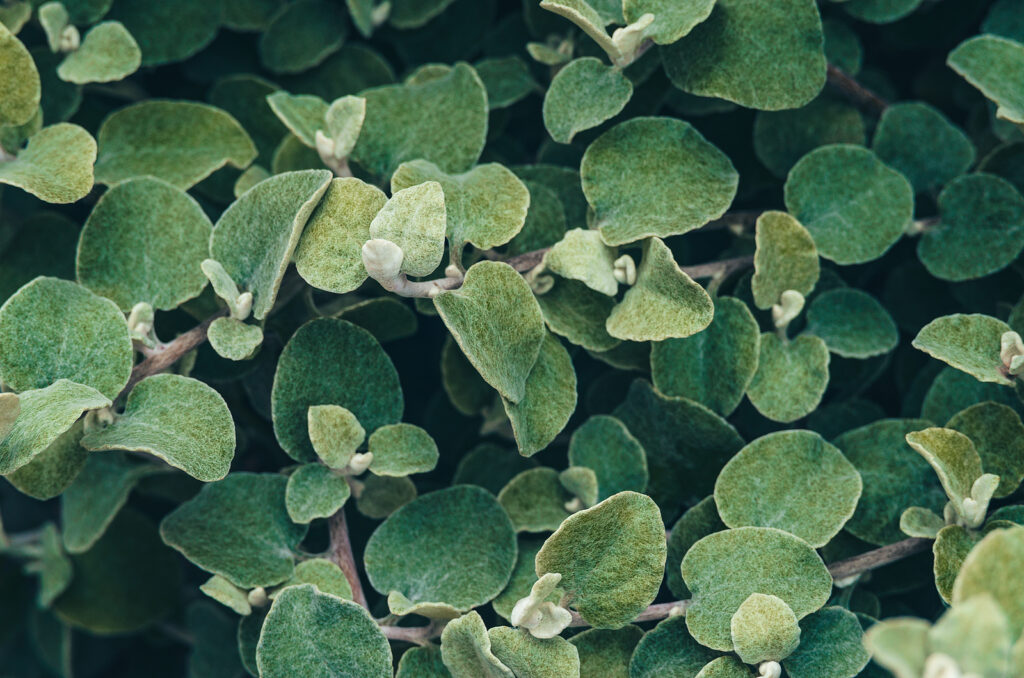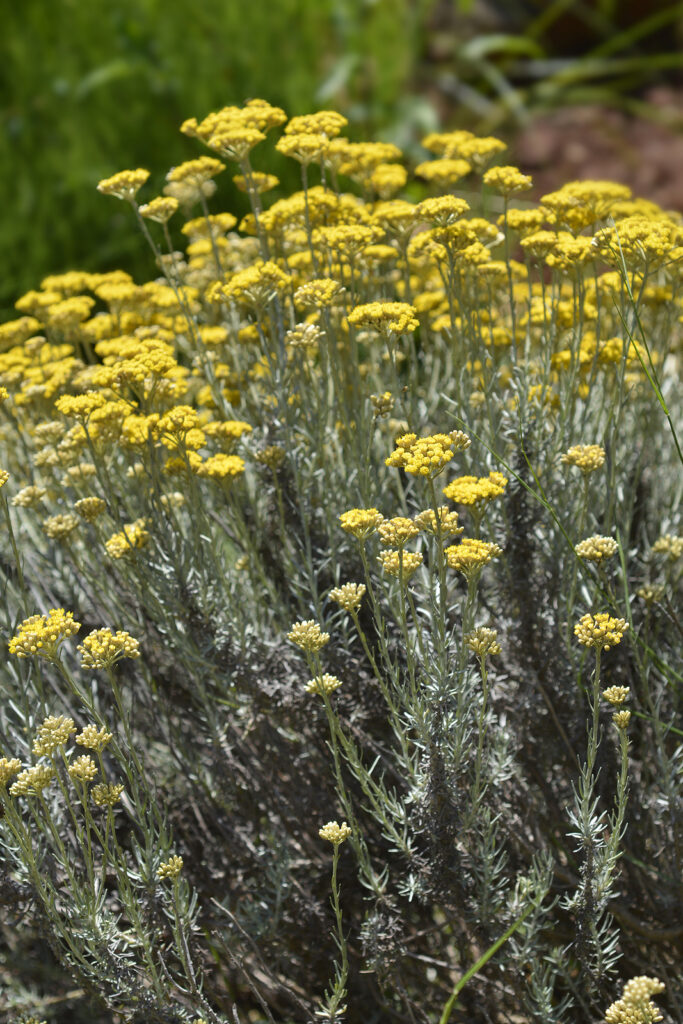Helichrysum–commonly called strawflower–bears daisy-like flowerheads with papery, white, yellow, or pink bracts and central yellow corollas. The flowers are nearly stalkless growing above broad lance-shaped hairy leaves.
Some species of Helichrysum are grown to be cut and dried as “everlasting flowers. They are often included in floral arrangements. Others are grown for their silvery, gray foliage, not their flowers.
There are about 500 species in the Helichrysum genus. Species include annuals, perennials, and subshrubs.
Flower Garden Success Products at Amazon:
- Wildflower Seed Mix Attracts Hummingbirds and Butterflies
- Eden Brothers All Perennial Seed Mix
- 10 pcs Stainless Steel Garden Hand Tool Set
- Gorilla Cart 4 Cu. Ft, 300-pound Capacity
- Neem Bliss 100-% Cold Pressed Neem Oil
- Safer Brand Insect Killing Soap

Get to know strawflowers — Helichrysum
- Plant type: Annual or tender perennial
- Growing Zones and range: Annuals in all zones; perennial in Zones 8 (with mulch protection) to 11; start plants indoors in Zones 3 to 5.
- Hardiness: Tender perennial
- Height and width: 12 to 48 inches (30-123cm) tall; 6 to 10 inches (15-25cm)wide
- Foliage: Alternate leaves on hairy stems are alternate, sometimes opposite, or in basal rosettes.
- Flowers: Daisy-like flower heads with central discs and strawlike pointed petals; blooms have dry, straw-like texture colors including orange, pink, red, white, bronze, and purple
- Bloom time: Mid- through late summer
- Uses: cutting and drying, bedding
- Common name: Strawflower
- Botanical name: Helichrysum bracteatum
- Family: Asteraceae
- Origin: Widely distributed in Europe, Asia, and Africa
Where to plant strawflowers — Helichrysum
- Plant Helichrysum in full sun.
- Helichrysum will grow in average to humus-rich, well-drained; strawflower will grow in alkaline soil.
- Helichrysum prefers a soil pH of 6.5 to 7.5.
- Helichrysum thrives in dry areas and on hillsides.
Strawflowers — Helichrysum uses
- Tall varieties of Helichrysum offer a colorful accent; they are best planted at the back of a garden.
- Dwarf Helichrysum provides bright colors for a rock garden.
- The papery flowers of Helichrysum hold their color indefinitely when dried. (To dry, pick flowers that are fully open; hang them upside down in a shady spot.)
- Helichrysum is beautiful in fresh arrangements.

When to plant strawflowers — Helichrysum
- Set Helichrysum in the garden in spring after the last frost has passed.
- Start seed indoors 8 weeks before the last frost in spring.
- Sow seed outdoors 2 weeks before to 2 weeks after the last frost ins spring.
- In Zones 10 and 11, sow seed in late autumn for blooms the next spring.
Planting and spacing strawflowers — Helichrysum
- Sow seeds by pressing them into a sterile seed starting medium indoors or in evenly prepared soil outdoors.
- Keep seed at 60° to 70°F (15.6°-21°C); seeds will germinate in about 10 days.
- Grow young plants in bright light or below a fluorescent light until plants are 4 to 6 inches (10-15cm) tall.
- Space Helichrysum 6 to 10 inches (15-25cm) apart in the garden.
How to water and feed strawflowers — Helichrysum
- Helichrysum needs light watering; keep the soil evenly moist.
- Mature plants are drought-tolerant.
- Helichrysum need only light fertilizing if at all; fertilize with an all-purpose fertilizer early in the growing season.
Good Products for Seed Starting Success at Amazon:
- Jump Start Germination Station w/Heat Mat Tray, 72-Cell Pack, Dome
- Espoma Seed Starting Mix
- 200 Count- Jiffy 7 Peat Soil Seed Starting Plugs
- Seed Starter Kit with Humidity Dome (120 Cells Total Tray)
- AgrobriteT5 Fluorescent, 2-Foot, Grow Light System
Strawflowers — Helichrysum care
- Long-stemmed varieties need staking or they will flop.
- Mulch around plants in dry regions to conserve soil moisture.
- Pinch back growth tips to keep plants bushy.
- Protect Helichrysum in winter by mulching with chopped leaves or straw.
- Harvest flowers for drying before they are fully open; hang them upside down in long-stemmed bunches to dry.
Strawflowers — Helichrysum pests and diseases
- Helichrysum is susceptible to aster yellows virus and aphids.

Strawflowers — Helichrysum propagation
- Helichrysum is propagated by seed; they easily self-sow.
- Seeds germinate in 7 to 10 days at 70° to 75°F (21°-24°C).
- Perennial Helichrysum can be propagated from cuttings taken in summer or by division in spring.
Strawflowers — Helichrysum varieties to grow
- Helichrysum bracteatum, strawflower: Annual grows 24 to 36 inches (61-91cm) tall with many flower heads; pompon-like summer flower to 2 inches across are papery and last indefinitely when dried; flowers may be yellow, orange, red, pink, or white; dwarf cultivars also available;
- H. italicum, curry plant: Perennial; spreading stems to 24 inches (61cm) tall and wide; narrow, nearly white leaves to more than 1 inch long; leaves emit a strong fragrance of curry powder when bruised; small bright yellow flowers in clusters 2 inches across.
- H. petiolare, licorice plant: Perennial with trailing stems to 4 feet (1.2M0 long; white, woolly, inch-long leaves; insignificant flowers; cultivar ‘Limelight’ has light chartreuse leaves, ‘Variegatum’ has leaves with white markings.
Strawflowers frequently asked questions
Q: Can I grow strawflowers from seed?
A: Sow strawflower seeds indoors 6 to 8 weeks before the last frost in spring. Set plants in the garden or sow seeds directly in the garden on the last average frost date. You do not need to cover strawflower seeds for germination to occur.
Q: What growing conditions do strawflowers favor?
A: Strawflowers can thrive in average to humus-rich soil. Keep the soil just moist, not wet. Strawflowers love long, hot, sunny summers.
Related Articles:
- 20 Perennials That Bloom for 6 to 8 Weeks
- Shrubs with Showy Flowers Season-by-Season
- Trees in Garden Design
- Growing Annuals for Summer Bloom
- Trees—click here for more articles
- Shrubs—click here for more articles
- Perennials—click here to see more
- Annuals—click here to see more















